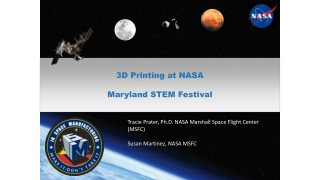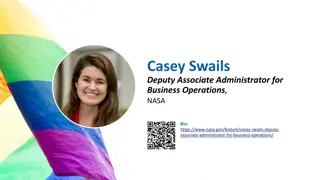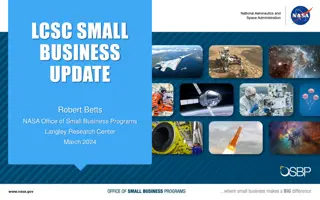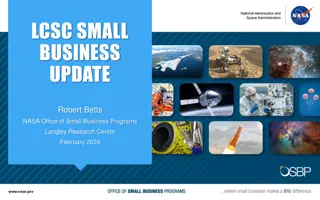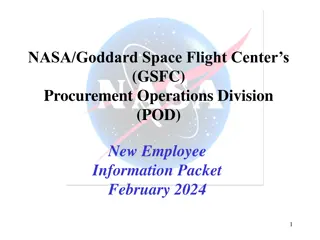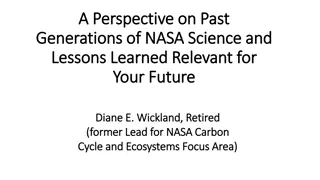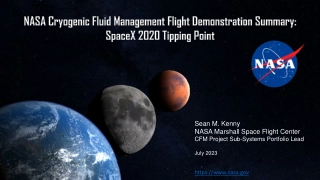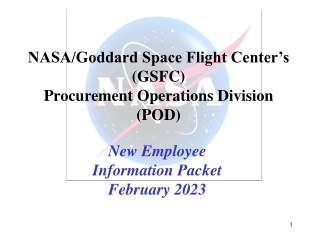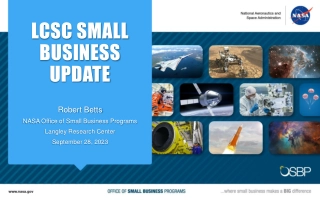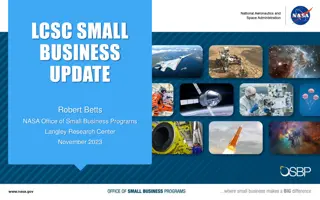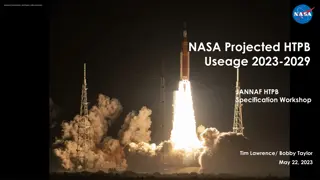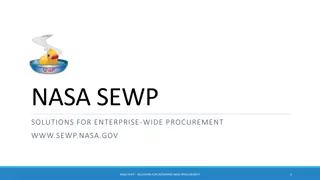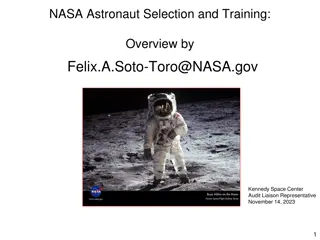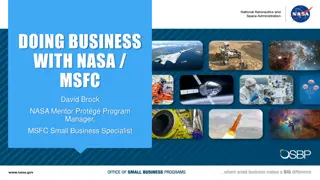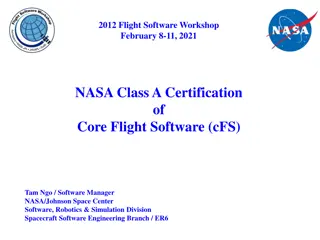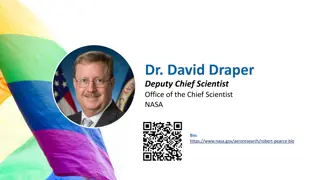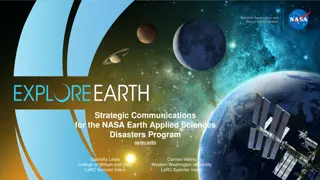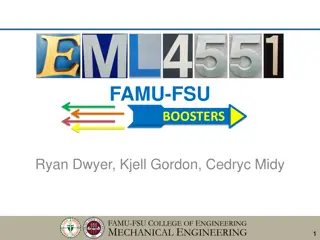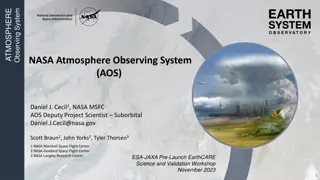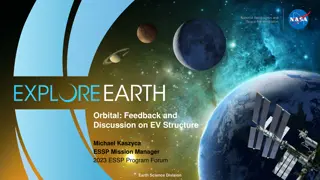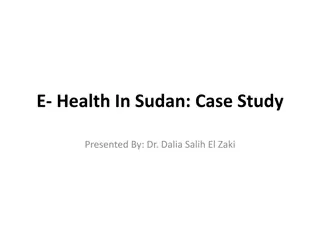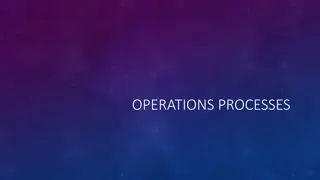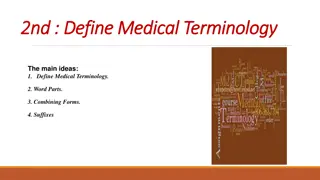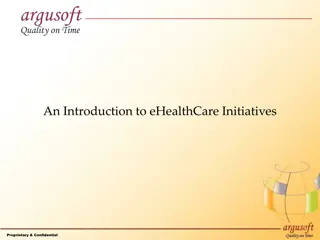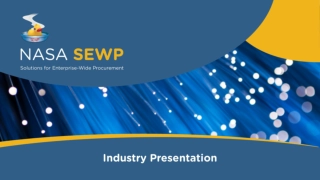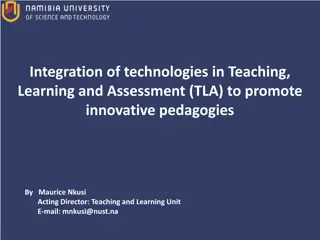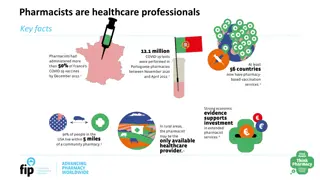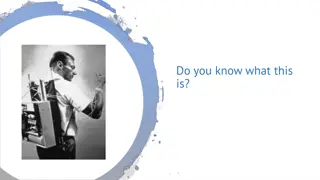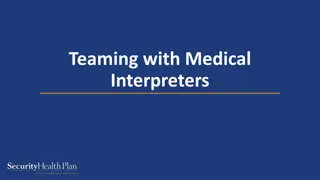Innovative NASA Medical Technologies Transforming Healthcare
NASA's groundbreaking technologies are revolutionizing healthcare, including active pixel sensors for dental imaging, mini-heat pipes for brain surgery, and fluorescent diagnostic test readers for fast results. These advancements improve accuracy, efficiency, and patient comfort, showcasing the impact of space research on medical innovation.
Download Presentation

Please find below an Image/Link to download the presentation.
The content on the website is provided AS IS for your information and personal use only. It may not be sold, licensed, or shared on other websites without obtaining consent from the author. Download presentation by click this link. If you encounter any issues during the download, it is possible that the publisher has removed the file from their server.
E N D
Presentation Transcript
Active Pixel Sensors Lead Dental Imagery into Digital Age Jet Propulsion Laboratory (JPL) Schick by Sirona Dental Long Island City, New York NASA Technology Complementary metal oxide semiconductor (CMOS) active pixel sensors invented at JPL allow smaller, more efficient digital imagers than those based on charge coupled device Other camera electronics can be integrated onto chip with pixel array: first camera on a chip Technology Transfer Benefits Shick Technologies and JPL entered into Technology Cooperation Agreement to develop technology, adapt it for dental X-ray imaging Schick obtained an exclusive license for CMOS dental imaging Schick, now part of Sirona Dental, enjoys energy-efficient, battery-operated X-rays and smaller, more comfortable intraoral sensors X-rays benefit from boom in CMOS imager industry, bringing higher quality, lower costs Spinoff 2017 Health and Medicine
Mini-Heat Pipes Wick Away Heat in Brain Surgery Glenn Research Center Thermacore Inc. Lancaster, Pennsylvania NASA Technology Heat pipes are like a superhighway for heat they move a lot of heat quickly NASA first became interested in the early days of spaceflight, to even out temperatures on non-rotating satellites A recent SBIR contract funded research to passively cool fuel cells, which produce electricity Benefits Mini-heat pipes in bipolar forceps improve brain surgery outcomes; offer increased precision and shorten procedures Technology Transfer Thermacore has had more than 40 SBIR contracts since the 1980s, including the fuel cell project The ultra-thin vapor chambers designed for NASA s fuel cells won a 2014 R&D 100 Award SBIR contracts helped Thermacore advance heat pipe tech for many applications, including medical Just 2.2-mm in diameter to fit within bipolar forceps, they work with and against gravity Heat pipes also help with blood warmers to ensure even distribution of heat, and in a number of other medical applications Spinoff 2017 Health and Medicine
Fluorescent Diagnostic Test Readers Offer Fast, Low-Cost Results Ames Research Center Cellmic LLC Los Angeles NASA Technology To medically diagnose astronauts in space, Ames awarded two SBIR contracts to Intelligent Optical Systems to create rapid diagnostic tests to be analyzed by a smartphone-based reader The company subcontracted Cellmic, then known as Holomic, to build the smartphone interface Technology Transfer Benefits Already able to analyze lateral flow test strips in visible light, Cellmic developed reader that uses ultraviolet light for amplified results Developed electronics, software to use phone s microprocessor to evaluate samples Cellmic and IOS delivered capability to rapidly detect one cardiac and three liver biomarkers Cellmic markets resulting HRDR-300 Fluorescent Immunoassay Reader to companies that develop their own test strips Low cost, portability, ease of use, rapid results all benefit use in remote locations Communications capability lets test results, locations be sent to central database Spinoff 2017 Health and Medicine
Cooling Garments Find New Medical, Athletic, and Industrial Uses Ames Research Center WElkins LLC Downers Grove, Illinois NASA Technology In the 1960s and 70s Bill Elkins worked on liquid cooling garments for NASA and the Air Force Tubes threaded through suits carried water cooled by a heat exchanger With Ames researchers, Elkins developed system of thin panels holding liquid-filled channels for cooling Technology Transfer Benefits Elkins founded several companies that applied liquid cooling to medical, athletic, and industrial uses After founding WElkins LLC in the 1990s, Elkins was contacted by a doctor interested in using cooling to mitigate brain damage caused by stroke and head trauma 2004 pilot study showed strong potential Strokes, heart attacks, brain injury, sedation during surgery decrease oxygen flow to parts of brain; cooling diminishes need for oxygen, also decreases inflammation from injury. WElkins Cooling Headliner approved by FDA Company also markets systems to athletes for improved performance, head trauma treatment, and to workers wearing heavy protective gear Spinoff 2017 Health and Medicine
Space-Based Bone Scanner Expands Medical Research Johnson Space Center Techshot Inc. Greenville, Indiana NASA Technology One of NASA s ongoing areas of research is learning what happens to bones after long-term exposure to zero gravity conditions This includes studies of astronauts as well as experiments on animals (such as mice) in space Technology Transfer Benefits Johnson worked with the Center for the Advancement of Science in Space (CASIS) to upgrade laboratory facilities on the space station CASIS partnered with Techshot to develop a bone densitometer that could be deployed on the ISS and operated by astronauts without exposing them to harmful radiation The resulting device, dubbed Bone D, is now in commercial operation on the ISS Companies rent the facility through Techshot, which maintains a ground-based mission control to monitor the instrument and acquire real-time data from experiments Spinoff 2017 Health and Medicine
Temperature-Regulating Fabrics Keep Babies Comfortable Johnson Space Center Embrace Innovations San Francisco NASA Technology To keep astronauts comfortable, spacesuits use active liquid cooling garments Under Johnson SBIR contracts, Triangle Research and Development Corporation tried more passive methods, microencapsulating phase change materials and infusing them into threads and fabrics Technology Transfer Benefits Gateway Technologies licensed exclusive patent for incorporating temperature-regulating phase change materials into fibers and fabrics Now known as Outlast, company supplies fabrics with phase change materials to companies that make clothes, bedding, sleeping bags, and more Embrace Innovations uses Outlast fabric in line of Little Lotus baby swaddles and sleeping bags Keeps babies comfortable, reduces risk of overheating, which is linked to sudden infant death syndrome Sales support Embrace s nonprofit arm in efforts to save premature babies in developing world Spinoff 2017 Health and Medicine
Reconfigurable Radio Tracks Flights Worldwide Glenn Research Center Harris Corporation Palm Bay, Florida NASA Technology NASA needs powerful radios to communicate with satellites, rovers, and astronauts to control machinery and receive data A higher bandwidth radio will make it easier to send large packets of data more quickly The software can also be reconfigured remotely, allowing for future updates or repairs Benefits Harris AppSTAR hardware and software can both be reconfigured, so it s easy to customize. One major client, Aireon LLC, will use the radio to track flights worldwide, filling large existing gaps over water or wilderness, allowing planes to fly more direct routes, with less space between them Another client will use orbiting radios to track ships at sea Technology Transfer The radio was tested as part of the Space Communication and Navigation (SCaN) Testbed, an experimental communication system on the ISS Developed under a 50/50 Cooperative Agreement, the radio won a 2013 R&D 100 Award Spinoff 2017 Transportation
Design Software Shapes Future Sonic Booms Ames Research Center Aerion Technologies Colombus, Ohio NASA Technology Computational Fluid Dynamics mimics wind tunnel testing to see how an air- or spacecraft will perform Early versions of the software were very time- consuming and difficult to implement Cart3D automates the process of mapping a grid, or mesh, around the vehicle in the computer model Benefits Technology Transfer Ease of creating mesh means many solutions can be run quickly, so engineers can see trends Engineers can work backwards from performance they want the craft to achieve GoCart is easy enough that students at universities and intermittent users can use it without difficulty Desktop Aeronautics, now Aerion Technologies, licensed Cart3D to use for designing a supersonic business jet and to sell the software commercially Added a graphical user interface and other features to make it easier for non-experts to use Also bundled other required applications so user only needs to launch one program, GoCart Spinoff 2017 Transportation
Orion Parachute Innovations Carry Commercial Rockets Back to Earth Johnson Space Center Airborne Systems, Space and Recovery Systems Santa Ana, California NASA Technology Johnson wanted the Orion spacecraft s parachute system based on Apollo s parachutes, but with updates and improvements Johnson brought on Airborne Systems as a subcontractor to build the parachutes to NASA specifications Technology Transfer Benefits Airborne Systems has built and sold parachute systems based on its Orion work to companies like SpaceX, Boeing, and Blue Origin, who use them to recover their respective spacecraft Vent lines are replaced with vent hoops to reduce risk of tangling, while textile reefing loops can t be crushed during packing Pyrotechnic reefing cutters are better controlled NASA carried out millions of dollars in necessary drop testing, money that Airborne customers don t have to spend Spinoff 2017 Transportation
CO2 Sensors Monitor Vehicle Emissions from Above Langley Research Center Hager Environmental and Atmospheric Technologies (HEAT) Inc. Knoxville, Tennessee NASA Technology The ASCENDS project at NASA hopes to learn more about how carbon dioxide (CO2) seasonally concentrates and dissipates in the atmosphere A sensor developed at Langley for the project would use a trio of lasers to take CO2 readings from space, including in darkness or through cloud cover Technology Transfer Benefits Contractors working on the project brainstormed other possible uses for such a sensor John Hager, one of the contractors, decided to leave NASA and found his own company, HEAT, to commercialize the technology HEAT s first product, Emissions Detection and Reporting (EDAR), analyzes car exhaust from remote sensors installed above roads Four states have deployed EDAR systems to audit emissions from vehicles In the future, the system could replace the need for drive-in emissions tests Spinoff 2017 Transportation
Software Opens Computational Fluid Dynamics to the Uninitiated Ames Research Center Sukra Helitek Inc. Ames, Iowa NASA Technology With the help of Ames SBIR contracts, Sukra Helitek released its Rot3DC program for modeling rotor air flows in 2000 Under another series of Ames SBIR contracts, culminating in 2010, the company created RotCFD, short for rotor computational fluid dynamics Technology Transfer Benefits Company automated creation of a three-dimensional grid that defines the space around the rotorcraft, normally painstakingly created by hand Development simplified some high-fidelity details to speed up code while still producing reliable results, and added user-friendly interface Added ability to predict how rotor-generated flows will interact with buildings, other objects Previously, even NASA rotorcraft designers relied on CFD specialists to analyze designs; they now save time and money RotCFD can solve for complicated, exotic problems but is designed for ease of use Can introduce college and even high school students to an otherwise esoteric subject Spinoff 2017 Transportation
Hydraulic Carts Streamline Structural Tests for Aircraft and Space Vehicles Armstrong Flight Research Center Moog Inc. East Aurora, New York NASA Technology Armstrong s Flight Loads Laboratory tests aircrafts structural strength and endurance, applying pressure with hydraulic actuators and measuring strain Its outdated system included a jungle of wires, hoses, and cables connecting gauges and actuators to the control room Technology Transfer Benefits Armstrong contracted Moog to build a system of hydraulic carts that could be rolled around the high bay, each connecting eight actuators and attendant gauges to a front-end computer with minimal wiring The lab purchased 10 SmartCARTs, which now carry out everyday operations At least one major helicopter producer has purchased a set of 10 SmartCARTs Moog estimates system saved Armstrong $350,000 in reduced cable quantity and infrastructure costs Eliminates tripping hazards, space constraints, annoyances of traditional setup Ideal for facilities that test a variety of vehicles, requiring frequent reconfiguration Spinoff 2017 Transportation
Orion Video Requirement Advances High-Speed, Compact Cameras Johnson Space Center Integrated Design Tools (IDT) Pasadena, California NASA Technology To film parachute deployment during an Orion spacecraft test flight, Johnson engineers needed a small, lightweight, rugged, high-speed digital camera The camera would need to back up data almost as fast as it recorded it so no data could be lost in the event of a power outage Technology Transfer Benefits Johnson contracted Integrated Design Tools, which specializes in cameras for scientific and industrial uses, such as crash testing IDT built a palm-size, rugged camera that could transfer 10 to 12 gigabits per second to its hard drive, adjust to changes in light within milliseconds, and be programmed to record a sequence of events at varying frame rates, shutter speeds, and durations All of IDT s new Os line of cameras, in which the O stands for Orion, incorporate the high- speed memory developed for NASA High-speed backup ensures crash test data is secure before anything happens to cameras, lets film crews move on without backing up a slow- motion sequence, and lets military testers film and fire one test shot after another Spinoff 2017 Public Safety
Rocket Technology Stops Shaking in Its Tracks Marshall Space Flight Center Thornton Tomasetti New York, New York NASA Technology Ares I had a vibration problem the first stage rocket booster caused a resonance with huge amplitudes dangerous for vehicle and crew Traditional dampers would add too much mass Marshall engineers designed a device that worked with fuel mass in second stage rocket Benefits Technology Transfer Fluid Harmonic Damper uses conventional piping in water: cheaper and easier to make and install than traditional dampers Design-engineering firm Thornton Tomasetti obtained a research license to test the technology for their structures and then entered a Space Act Agreement to confirm more details Satisfied, they then licensed the patent for exclusive rights to use the device in bridges and buildings Inventors won NASA s Exceptional Engineering Achievement Medal and got about a dozen patents Device causes movement in the water, so it no longer acts as part of the overall structure a paradigm shift in vibration mitigation Can be used to mitigate shocks from an earthquake or swaying from heavy winds and any other cause of dangerous vibrations Spinoff 2017 Public Safety
Micromachined Sensors Monitor Train Rails, Predict Failures Glenn Research Center Ridgetop Group Inc. Tucson, Arizona NASA Technology Under SBIR contracts with Glenn, Ridgetop developed tiny, sturdy motion sensors to mount on gears in a helicopter transmission and the software to identify anomalies in data they transmitted Testing on Glenn s Helicopter Transmission Test Stand showed the system could predict failures Technology Transfer Benefits Ridgetop adapted its RotoSense sensors to be mounted on train axles, where they monitor vibrations Software to identify the significance of any anomalies was rewritten specifically for rail Testing of the new RailSafe system at the Federal Railway Administration s Transportation Technology Center showed promise; RailSafe launched in 2015 The ability to detect a problem in a train rail can avert catastrophe Ridgetop offers installation and training for the kit sensors, data collection hub, and software The system is planned to one day be able to predict useful life of both wheels and rails and warn of failures before they occur Spinoff 2017 Public Safety
Wire Sensors Alert to Dangerous Conditions in the Clouds Glenn Research Center Anasphere Inc Bozeman, Montana NASA Technology At high altitutes, ice can easily coat airplane wings and even engines, a common hazard for flying NASA is developing a ground-based system to detect icing conditions and, to verify its results, needed to fly sensors to test when the hazard is present NASA wanted a lightweight, inexpensive sensor that could fly on weather balloons Benefits Inexpensive, low power super-cooled liquid water sensor allows researchers to use multiple units together to develop a vertical profile Technology Transfer Can be used with Anasphere s Tethersonde, so they can be reeled back in and re-used Anasphere founder John Bognar had an idea for a vibrating wire sensor using piezoelectric elements He got a Phase I SBIR contract to develop it and a Phase III SBIR contract to produce more for NASA In 2015, sensor was a finalist for an R&D 100 award Department of Energy uses them in cloud formation studies in the Arctic; a Chinese company will market them to farmers to warn when icing conditions threaten crops Spinoff 2017 Public Safety
Fast-Flow Nanofiber Filters Purify Water at Home and in the Field Johnson Space Center Water Pure Technologies Murray, Utah NASA Technology Astronauts need to reuse and recycle every drop of water, meaning high level filtration to make it safe Many inexpensive filters cannot filter out viruses or many bacteria and single-celled organisms Powerful filters are often extremely slow, because they have membranes with tiny pores to block contaminants Benefits Water ResQ line includes several multi-stage filtration systems, both portable and installed Technology Transfer Argonide discovered NanoCeram fibers made excellent water filters, because they were strongly bioadhesive bacteria and viruses stuck to them Technology was developed under two SBIRs Argonide licenses the technology to other companies for sale. Water Pure buys from them NanoCeram filter eliminates more than 99.9% of viruses and bacteria without chemicals Larger pore size 2 microns allows filter to work fast, key for goal of offering systems that filter a lot of water at a very low cost Clients include California fire-jumper brigades Spinoff 2017 Public Safety
Miniaturized Vacuum Pumps Play Big Roles on Mars and Earth Jet Propulsion Laboratory (JPL) Creare Inc. Hanover, New Hampshire NASA Technology One of Curiosity s most pressing objectives was to assess the surface chemistry of Mars for clues to its watery past The Sample Analysis at Mars spectrometer was designed to perform this task and required a lightweight, rugged vacuum pump Technology Transfer Benefits JPL hosted a series of workshops in the late 1990s to find a company capable of making the device Creare developed a relationship with JPL through the workshops and miniaturized one of its vacuum pumps through a series of SBIR contracts it won The company is also developing a pump for the European ExoMars rover, which launches in 2018 Creare s miniaturized vacuum pumps are used in spectrometers for a variety of industries, ranging from mining operations to chemical-weapon and bomb detectors The company is targeting future growth in the defense, healthcare, and environmental industries Spinoff 2017 Public Safety
CMOS Sensors Enable Phone Cameras, HD Video Jet Propulsion Laboratory (JPL) GoPro Inc. San Mateo, California NASA Technology Complementary metal oxide semiconductor (CMOS) active pixel sensors invented at JPL promise smaller, more efficient digital imagers than those based on earlier charge coupled device technology Other camera electronics can be integrated onto chip with pixel array: first camera on a chip Technology Transfer Benefits JPL inventor founds Photobit with exclusive license for CMOS imaging. Webcams, ingestible pill cameras for endoscopy, and more follow Photobit is sold; license returns to California Technical Institute Need for small, efficient cell phone cameras drives mass production of CMOS imagers, leading to improvements in quality, manufacture CMOS imagers enable small, high-definition video cameras; devices like GoPro body- mountable cameras fully leverage advantages CMOS takes over digital imaging, including automotive, surveillance, and medical fields Phone cameras revolutionize social media By 2015 CMOS imaging market nears $10 billion Spinoff 2017 Consumer Goods
Novel Threading Enables New Approach to Golf Clubs Goddard Space Flight Center Cobra Puma Golf Carlsbad, California NASA Technology When the Space Shuttle Program started using reusable engines, NASA was interested in fasteners that wouldn t jar loose under repeated vibrations A researcher at Goddard ran extensive tests on Spiralock, a new, alternative bolt threading; he detailed his findings in a 1984 paper Technology Transfer Benefits Thanks in part to the validating research, Spiralock came to be used in missiles, engines, oil wells, fiber- optic networks, human joint implants, and more Cobra Puma Golf wanted to commemorate a recent NASA collaboration with a spaceport door in its new driver, but the tiny door came loose after repeated strikes; the company consulted NASA research and discovered Spiralock threading Spiralock threading holds fast the spaceport door in the new KING LTD Driver The door offers unprecedented access into the club head, allowing precise weight placement Together with the weight of the door, this allowed for the first zero-center-of-gravity club, maximizing energy transfer from club to ball Spinoff 2017 Consumer Goods
Blue-Light-Cancelling Lens Gives Skiers a Clearer View Ames Research Center Optic Nerve Inc. Wheatridge, Colorado NASA Technology Human eyes are particularly sensitive to blue and green light, which comprise the middle wavelengths of the visible spectrum In the 1990s, an Ames scientists developed an optical filter that cancels blue and green light while amplifying other hues Technology Transfer Benefits NASTEK, a company based in Oregon, entered a Space Act Agreement with Ames to utilize the research The company developed its own line of optical filters based on the technology and partners with other companies to incorporate it into consumer products Optic Nerve is the latest company to partner with NASTEK, resulting in a line of ski goggles The lens cancels as much as 95 percent of blue light, giving the average wearer an increase of 12-15 percent in visual acuity and depth perception Spinoff 2017 Consumer Goods
Rechargeable Hearing Aid Batteries Draw from NASA Research Glenn Research Center ZPower LLC Camarillo, California NASA Technology Silver-zinc is the most mass-efficient battery couple but degrades very easily In the 1960s and 70s, researchers at Glenn worked to mitigate degradation and make the batteries rechargeable Technology Transfer Benefits Zinc Power Matrix, now called ZPower, was founded in 1996 and used NASA s research, which was made public, as part of its starting point toward the first commercial rechargeable silver-zinc batteries After long research and development, ZPower released its first commercial, rechargeable silver- zinc cells in 2013 These are the first rechargeable hearing aid batteries to hold a charge for more than a day Custom battery door allows overnight charging without handling tiny batteries Batteries are recycled and kept out of landfills ZPower plans to expand to other wearable electronic applications Spinoff 2017 Consumer Goods
Large-Scale 3D Printer Brings Manufacturing to the Masses Johnson Space Center re:3D Houston, Texas NASA Technology NASA sent a 3D printer to the ISS to to explore printing needed items on long-duration missions A series of successful test prints included a ratchet, the first item printed from a design sent from Earth 3D printing could one day print objects that can t be launched Technology Transfer Benefits A group of Johnson employees wanted to make large-scale 3D printing available in the developing world Engineer Matthew Fiedler, who honed skills in the neuroscience lab of Johnson s human research program, designed Gigabot in his garage Johnson and Langley have both bought Gigabots Standard configuration prints 30 times larger than competing desktop models, up to 8 cubic ft. Units start at just $8,550, far less than other large-scale printers Fiedler designed the system to be easy to use, sturdy, and reliable One printer donated for every 100 sold Spinoff 2017 Consumer Goods
Professional Development Program Gets Birds-Eye View of Wineries Langley Research Center Virginia Wine Board Richmond, Virginia NASA Technology Each year up to 400 students and professionals in science, technology, math, and science participate in 80 projects under NASA s DEVELOP Program DEVELOP, headquartered at Langley, carries out all projects using Earth-observation data Technology Transfer Benefits The U.S. Department of Agriculture stopped providing the Virginia Wine Board with detailed vineyard acreage data several years ago A Langley scientist, also DEVELOP s national science advisor, oversaw a team s effort to use Landsat data to map Virginia vineyards The team confirmed about 80 percent of the self- reported acreage tracked in Wine Board member surveys Participants discovered discrepancies, such as wineries listed in one county with significant acreage in other counties Future work could classify grape plots Spinoff 2017 Consumer Goods
Carbon Nanotube Resin Shores Up Boats, Bikes Johnson Space Center Zyvex Technologies Colombus, Ohio NASA Technology At 100 times the strength of steel and1/6 the weight, carbon nanotubes are attractive for spacecraft NASA didn t discover CNTs but was instrumental in funding research to solve challenges in using it CNTs are flat carbon sheets that roll up, but they tend to clump together in mixtures Technology Transfer Benefits SBIR contracts in 2003 and 2006 funded research on incorporating CNTs into a functional material and using that material as a lightweight radiation shield A polymer treatment helped CNTs disperse evenly in resin to strengthen composite materials Working with NASA , Zyvex was able to achieve high concentrations of CNTs with excellent dispersion CNT-infused resin makes already tough composites even tougher while maintaining or increasing stiffness and reducing wear Zyvex sells 6 formulations of CNT additives for resins, under the ZNT product name It also sells composites pre-treated with a CNT- infused epoxy under the Arovex product name Spinoff 2017 Consumer Goods
GPS Correction Technology Lets Tractors Drive Themselves Jet Propulsion Laboratory (JPL) John Deere Moline, Illinois NASA Technology JPL developed the first global tracking system for GPS satellites, followed by Real-Time GIPSY software to stream satellite tracking data in real time Together these constitute one of NASA s most important contributions to modern society, enabling accurate GPS navigation anywhere on Earth Technology Transfer Benefits John Deere and subsidiary NavCom independently developed GPS-based guidance for farm equipment In 2001 John Deere licensed Real-Time GIPSY and contracted with JPL to receive data from the center s global network of reference stations Company s 2004 StarFire system, using JPL software and ground stations, was first global GPS for farm equipment that didn t require signal towers GPS guidance eliminates overlap of tractor rows in fields, saving seed, fertilizer, pesticide, time, fuel, and machine wear while reducing runoff and allowing more accurate crop yield maps John Deere let license expire after developing its own system, but not before partnership improved farm guidance technology, took it worldwide, and popularized idea of precision agriculture Spinoff 2017 Energy and Environment
Controlled-Release Fertilizer Takes Root in Fields, Groves Worldwide Kennedy Space Center Florikan Sarasota, Florida NASA Technology Veggie project aims to grow food in space for long- duration voyages Soil can be inconsistent, so researchers chose a porous baked-clay substrate, and rely on fertilizer to provide nutrients Market testing found best fertilizer for the project was Florikan controlled-release fertilizer Benefits Technology Transfer Patents bought by J.R. Simplot company, which now sells fertilizer as Gal-Xeone. Florikan maintains license to sell product in eastern US Florikan fertilizer was developed with 40 hours of NASA SATOP consulting, which helped perfect the polymer coating method Awarded the Gulf Guardian Award by the US EPA Created new formulations of nutrients based on plants Veggie plans to grow next, which are now offered for sale Controlled release means nutrients get where need, when needed, so can use less, avoiding damaging run-off into groundwater One application can last 6 or 9 months, meaning less work overall Spinoff 2017 Energy and Environment
Satellite Imagery Sheds Light on Agricultural Water Use Goddard Space Flight Center Google Mountain View, California NASA Technology Landsat Earth-observing satellites capture images of the Earth s entire surface every 8 days Infrared pictures, via thermal imagers on Landsat 7 and 8, can help show levels of evaporation and transpiration, which have cooling effects Technology Transfer Benefits University of Idaho professor Rick Allen began using Landsat imagery in 1999, thanks in part to a grant from NASA aimed at boosting Landsat usage Allen developed an algorithm, METRIC, using Landsat images to map evapotranspiration as a way to monitor water use across large regions When NASA and USGS made Landsat data freely available, Google used it to create Google Earth Engine, to facilitate research access EEFlux adapts METRIC to work with Earth Engine, so anyone with Internet access can use Landsat data to create an evapotranspiration map within seconds Early beta users include California Department of Water Resources and the World Bank Helps monitor water use to see if it s sustainable, if it s growing, if a drought is starting Spinoff 2017 Energy and Environment
Building Sensors Monitor Power Usage, Device by Device Ames Research Center Verdigris Technologies Inc Moffett Field, California NASA Technology Sustainability Base was designed to be the greenest, most energy-efficient federal building Needed a way to monitor energy consumption by occupants, to find other ways to reduce energy use Sensor plugs into circuit panel and uses deep packet algorithm to break out usage by device Technology Transfer Benefits Verdigris had developed the sensor, approached NASA about a research partnership Non-reimbursable Space Act Agreement, to validate device in Sustainability Base, accelerated development, because of the expansive testing at NASA Possible future uses for NASA missions could alert to failures and breakdowns before they happen Sensor collects performance data in the cloud, so a device s energy consumption can be compared to a baseline System sends regular reports via email and can also be monitored on the Web or in app Customers so far include hotels, corporate offices, hospitals, and manufacturers Spinoff 2017 Energy and Environment
Earth Observation Spots, Helps Prevent Rainforest Fires Ames Research Center Conservation International Arlington, Virginia NASA Technology About two dozen NASA missions chart aspects of Earth s surface, oceans, and atmosphere from space NASA Earth Exchange (NEX) at Ames leverages supercomputing to analyze Earth-observation data Technology Transfer Benefits Conservation International (CI) won NASA funding to overhaul, combine rainforest fire-risk forecasting and fire-alert systems, both based on satellite data CI used NEX to prototype new fire-risk system, incorporating new satellite data, expanding territory OnSight platform made with Stennis Space Center SBIR augments fire-alert system, while Goddard Space Flight Center provides seasonal forecasts Fire-risk and fire-alert used to make Firecast Expanded Firecast forecasting from Bolivia to nine more countries OnSight lets users upload observations, data from ground to improve investigations, patrols Fire-alert helps stop illegal slash-and burn, while fire-risk helps plan controlled, legal burns Spinoff 2017 Energy and Environment
Mineral Analyzer Shakes Answers out of Soil and Rocks Ames Research Center Olympus Scientific Solutions America Waltham, Massachusetts NASA Technology Mineral analysis, through X-ray Diffraction (XRD), gives clues about whether Mars could support life Traditional XRD machines are big, heavy and require precise movements from the machine and in preparing the sample unrealistic for a rover CheMin vibrates the sample, allowing for a stationary X-ray beam and larger grains Benefits Technology Transfer TERRA, for fieldwork, and BTX II, for labs, are small, easy to use, and extremely rugged CheMin development started at Ames, and then continued under an SBIR with inXitu Inc, founded by one of the lead developers inXitu licensed the patents and sold the product to industry; in 2011, Olympus bought inXitu, and now sells the device in portable and benchtop models Each costs less than $100,000, compared to several hundreds of thousands for traditional lab- based XRD devices Largest market is in oil and gas exploration. Others include drug makers and watchdogs Spinoff 2017 Energy and Environment
Low-Cost Flow Meters Bring Efficiency, Reliability to Nuclear Plants Marshall Space Flight Center Graftel LLC Elk Grove Village, Illinois NASA Technology Under a 2001 Space Act Agreement, Marshall and Quality Monitoring and Control developed a meter to measure liquid oxygen flow in Space Shuttle engines The resulting balanced flow meter is a plate with several holes placed, numbered, and sized by proprietary software according to each application Technology Transfer Benefits Quality Monitoring and Control spun off A+ FlowTek to market the patented meters to aerospace companies, refineries, and chemical, power, and pharmaceutical plants, among others Graftel obtained an exclusive license to market A+ FlowTek balanced flow meters (BFMs) to the nuclear industry which has stringent standards and requirements making its first sales in 2013 BFM is highly accurate, with consistent results, even near pipe bends that throw off other meters Unlike other flow plates, does not cause drop in pressure of flow being measured, meaning operational efficiency is improved, money saved BFM is low-cost and long-lasting Doesn t produce loud noise like other flow plates Spinoff 2017 Energy and Environment
Computer Learning Program Inventories Farmers Fields Goddard Space Flight Center GeoVisual Analytics Boulder, Colorado NASA Technology NASA Center for Climate Simulation at Goddard works to assimilate, analyze Earth-observation data from NASA-built satellites GeoVisual Analytics proposed continuously updated global land-cover classification map and was awarded Goddard SBIR Technology Transfer Benefits Under SBIR contracts, GeoVisual used Landsat data to develop algorithm to analyze imagery, pixel by pixel, and assign vegetation index number and land cover classification to each dot Created Computer Learning Imagery Platform (CLIP) CLIP won attention of Taylor Farms, world s largest producer of fresh-cut vegetables, which became GeoVisual s first CLIP customer GeoVisual uses drone imagery to assess health, predict annual yields of Taylor Farms fields Company plans to go global, one day predicting annual worldwide yields of staple crops Spinoff 2017 Energy and Environment
Laser Imaging Helps Archeologists Dig Up History Goddard Space Flight Center Teledyne Optech Henrietta, New York NASA Technology Laser imagers, or lidars, first flew on Apollo 15 in 1971, and have aided in many NASA discoveries over the decades The upcoming OSIRIS-REx asteroid return machine will use a lidar scanner to build a 3D topographical map and help choose sample sites Benefits Technology Transfer Archeology is one of many fields now benefitting from laser imaging Lidar device maker Teledyne Optech has made imagers for several NASA missions, including OSIRIS-REx and earlier Phoenix Mars lander Space-ready lidars needed to be smaller, more rugged, and use less power innovations that translated well to commercial offerings Optech lidar on Phoenix lander discovered snow in Martian atmosphere Technology helps uncover features across a wide swath of landscape that are difficult to see with the naked eye Teledyne Optech device used in Beaver River region of Oklahoma to help discover artifacts from 10,500 years ago Spinoff 2017 Information Technology
Program Predicts Aerothermodynamics of Reentry, Subsonic Flight Ames Research Center Orbital ATK Dulles, Virginia NASA Technology Computational fluid dynamics (CFD) software could model aerodynamics and aerothermodynamics but was slow; faster programs weren t compatible with computer-aided design (CAD) software An Ames researcher created Configuration-Based Aerodynamics (CBAERO) program in early 2000s Technology Transfer Benefits Made available through software usage agreements in 2006, CBAERO has been used by more than 20 businesses, at least half a dozen military agencies, four universities, as well as all NASA field centers Nearly every company building commercial space vehicles uses CBAERO, including Orbital ATK, which has used it for its Cygnus spacecraft and various military projects Moves designs easily from CAD and into CFD Can model in seconds what takes thousands of hours in CFD, with results nearly as accurate Has batch mode, running automatic results on a family of vehicles with a range of designs Can create database of forces, temperatures across surfaces at range of speeds, angles, etc. Spinoff 2017 Information Technology
Data Acquisition System Captures Machine Performance Kennedy Space Center Dewetron Wakefield, Rhode Island NASA Technology To ensure the Space Launch System mobile launch platform works as intended, some 500 sensors measure strain, load, pressure, acceleration, etc. The results are all captured, store, and transmitted to the control center by a data acquisition system NASA needed a single, universal signal conditioner that could handle every kind of sensor Benefits The DAQP-STG was lower cost and smaller than competing universal signal conditioners and could handle more sensor types Dewetron incorporated updated versions of the signal conditioner in its subsequent data acquisition systems Technology Transfer Dewetron specializes in data acquisition systems, but the contract with NASA required something more powerful, more complicated Under contract, the company took an existing signal conditioner and increased its voltage input range, voltage isolation, and added other capabilities Sold many thousands of the conditioners, at around $1000 each, sometimes in orders of 800 or more Systems are used by car, aerospace and structural monitoring industries Spinoff 2017 Information Technology
Light-Analysis Software Explodes across Industries Jet Propulsion Laboratory Lambda Research Corporation Littleton, Massachusetts NASA Technology In 1993 JPL granted two SBIR contracts to Lambda to develop a user-friendly program for modeling light behavior, to predict stray light in NASA imagers The Terra satellite s Multi-Angle Imaging Spectroradiometer became the first NASA imager designed with the help of Lambda s TracePro Technology Transfer Benefits Before the second SBIR contract was finished, the first commercial version of TracePro was released TracePro was the first light-ray-modeling software compatible with CAD software and Windows Lambda discovered that a multitude of industries have an interest in predicting light behavior; TracePro remains the company s flagship product Biggest market is in optimizing overhead lighting Popular uses also in light pipes for electronics displays, design of solar collectors, virtual prototyping of car dashboard displays, and camera and telescope designs Multiple noninvasive health monitoring applications, plus laser and LED surgical devices Spinoff 2017 Information Technology
Connectors Link Data Networks for Orion, Industry Johnson Space Center Smiths Connectors Thousand Oaks, California NASA Technology For Orion spacecraft, Johnson wanted to replace multiple data networks of previous craft with single, integrated, one-gigabit Ethernet network New network required lighter, smaller, rugged connectors with higher-than-standard impedance to transmit more data at lower voltages Technology Transfer Benefits Smiths Connectors was selected as subcontractor in 2010; spent five years developing qualified connectors Connectors met all expectations during Orion s December 2014 test flight Based on Orion work, company released commercial High-Speed Ruggedized D-Sub connector Ability to endure harsh environments while quickly transmitting large amounts of data In commercial aviation, allows sensors near high-vibration areas like wings or engine Petroleum drilling endures high pressure, vibration; train data networks survive vibration Military, aerospace are also markets Spinoff 2017 Information Technology
Scheduling Software Plans Public, Private Space Missions Johnson Space Center Goddard Space Flight Center Orbit Logic Greenbelt, Maryland NASA Technology Alex and Ella Herz supported payload operations at Johnson in late 1980s, early 90s Alex, Doug George later built scheduling software for planned Vegetation Canopy Lidar at Goddard The trio founded Orbit Logic in 2000 Technology Transfer Benefits In partnership with two other companies, created STK Scheduler, the first generic, reconfigurable space-mission scheduling software; released in 2002 Program built on experience scheduling payloads at Johnson, building scheduling software at Goddard Instead of using massive spreadsheet, taking days to optimize schedule changes, STK Scheduler reschedules mission in seconds Over 250 customers have purchased license With constellations of dozens of satellites in the works, scheduling software becomes imperative Spinoff 2017 Information Technology
Power Amplifiers Boost Radar, Communications, Defense Systems Jet Propulsion Laboratory (JPL) QuinStar Technology Torrance, California NASA Technology QuinStar subcontracted in 2009 under JPL SBIR contract to build solid-state power amplifier (SSPA) for airborne radar to test equipment for future Surface Water Ocean Topography mission SSPA delivered was cheaper, more compact, more reliable than earlier, tube-based power amplifiers Technology Transfer Benefits Following initial success, JPL, other NASA entities and contractors ordered more QuinStar SSPAs Resulting innovations advanced QuinStar s commercial offerings, from environmental research radars to communications and electronic warfare SSPA packs capability of tube-based power amplifier about five times its size and weight Small, lightweight amplifier enables use on UAVs Other SSPAs lose 20 percent energy when recombining signals; QuinStar s lose 8 percent Collision avoidance, surveillance, defense are other possible applications Spinoff 2017 Information Technology
3D Weaving Technology Strengthens Spacecraft, Race Cars Ames Research Center Bally Ribbon Mills Bally, Pennsylvania NASA Technology A connection point on Orion s heat shield needed to be a powerful insulator and structurally strong Previous materials, such as woven steel and carbon fiber composites, proved insufficient insulators A new composite, 3D-woven quartz, is stronger and has extremely low thermal conductivity Benefits Technology Transfer 3D orthogonal weave, with fibers perpendicular in all directions, is strongest possible 3D-MAT can be a structure, an insulator, and a shock absorber and can carry loads The material, 3D-MAT, was funded in part through seed money from Ames and SBIR contracts Bally Ribbon built special equipment to make the 3- inch blocks and denser weave NASA required Company is working with Ames on other materials and considering how to use 3D-MAT elsewhere on Orion In addition to aerospace customers, race car companies are exploring larger, denser carbon fiber blocks made on equipment designed for NASA Spinoff 2017 Industrial Productivity
Vibration Tables Shake Up Aerospace, Car Testing Goddard Space Flight Center Team Corporation Burlington, Washington NASA Technology NASA tests all its equipment on vibration tables, to ensure it won t come apart during launch Team Corporation has been providing the test equipment since the 1950s, including for Vanguard 1, one of the first satellites ever launched Team built new, state-of-the-art vibration testing equipment for the James Webb Space Telescope Benefits Team specializes in high-end, custom equipment to meet customer needs Technology Transfer Over the decades, innovations Team has created for NASA projects have been included in their commercial offerings Stiff, frictionless Model 1830 T and V bearings were first made for a NASA shaker table, now found all over the world in Team products Shaker devices can recreate a bouncing road or a massive earthquake One big market is car industry, which tests car components as well as the assembled vehicle Also widely used in aerospace and defense industries Spinoff 2017 Industrial Productivity



